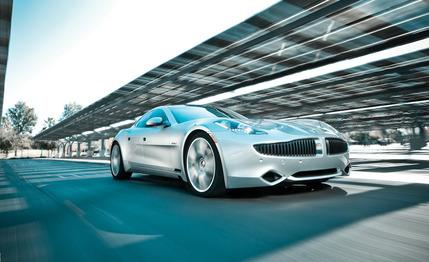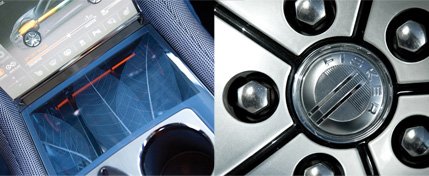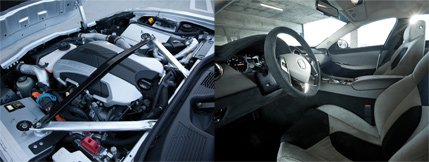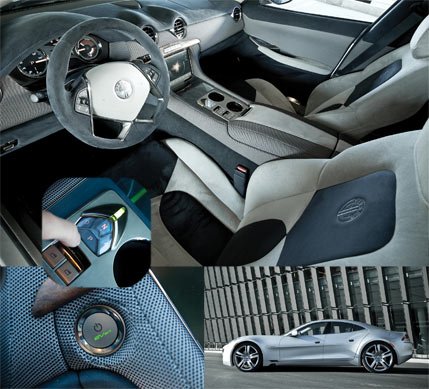
 Road Test
Road Test


Nobody can deny (can they?) that the Fisker Karma is the lewdest wedge of car porn to hit the pavement since the onset of the 5-mph bumper. From one 22-inch wheel to the other, the Fisker is a heartthrob, a design spectacularly unchained from the shackles of practicality and brand identity that enslave other automakers. It is an auto-show concept car before it has been horsewhipped into bland banality by the finance, marketing, and engineering departments. It is a car built by a company started by a designer.
The Karma also testifies to the many reasons why car companies are run by finance, marketing, and engineering types and not designers, especially designers like Danish ex–Aston Martin stylist Henrik Fisker, he of the handmade suits and the blow-dried blond coiffure.
The Karma’s wheelbase—124.4 inches, or about the same as a 1958 Edsel’s—is 9.4 inches longer than a Porsche Panamera’s. Yet the back seat is smaller than a Honda Fit’s. A Kia Rio’s trunk is more than twice the size of the Karma’s. You try packing two carfuls of powertrain into something this low: The Fisker saddles its aluminum space frame with one engine, one generator, two electric motors, a 315-cell lithium-ion battery pack, a roof-mounted solar panel, and three separate liquid-cooling systems, yielding a curb weight of 5297 pounds.


The cheapest version,the EcoStandard, costs $103,000, but if you desire a top EcoChic model such as this one, which is “animal-free,” it’s $116,000. Add $3200 for the sole option: sparkly silver paint—one of four “Diamond Dust” shades that includes bits of recycled glass. Groundup Opus One bottles, perhaps?
It sounds like a recipe for overcooked pretentiousness. Maybe it is, but even if you’re making a 57-point U-turn in the supermarket parking-lot aisle because the Karma’s turning circle is more than 40 feet, you look fabulous. Insert rock stars here.
But is the Karma real? We will attempt to answer that question now that we have a testable unit, just two years after the federal government loaned the company $529 million and spawned a mini-industry of devout skeptics. At this writing, Anaheim, California–based Fisker Automotive claims to have built 1250 production Karmas—one of which was supposed to be ours to test. But on the planned delivery day in late December, Fisker’s men said the car showed up with outdated software. In place of the production unit, the company handed over an engineering development car running the correct software on its onboard computers. Off we glided to the test track.


There’s a lot to like here. The Karma has good visibility to the sides and rear and especially forward over the Corvette-like batwing fenders and hood bulge. The front seats are plush and comfortable, not overly bolstered or sporty but, like an old La-Z-Boy, good for many hours of spinal serenity. The rear seats are confined and vertical, with little legroom and less headroom. Be prepared to apologize to those stuck in back as you scoot forward to make space.
No clichés of black leather and polished aluminum inside this machine. As advertised, our EcoChic spurns animal skins for an assemblage of blue and cream faux suede accented by broad swaths of coarse fabric mottled with blue nibs. Blocks of burled wood salvaged from California wildfires (or perhaps from well-furnished California houses burned by wildfires) complete the interior’s attractive feng shui.
Instead of conventional buzzes or dingdongs, the dash plays a medley of soothing hums and tones as part of the Karma’s pseudofuturistic theater. Gear selection is via buttons clustered onto a small pyramid on the center console. Push one, and the pyramid responds by sending an arc of green aurora borealis through the console as the car sings “hoo-huuumm.” At low speed, speakers located behind the bumpers announce the Karma’s presence to pedestrians with a . . . sound. Either it’s a simulated jet whine or a recording of the Large Hadron Collider making a black hole.


The two multicolor gauges—one for speed, one a consumption/generation meter with fuel-level and battery-charge indicators are high-res digital displays. Most buttons are of the virtual kind and embedded in a 10.2-inch touch screen. Steeringwheel paddles toggle three driving modes, including “stealth” or electric-only; “sport,” which more readily rouses the engine for greater accelerative power; and “hill,” which turns up the regenerative-braking function to take advantage of long downgrades.
Even in sport mode, the Karma is not particularly nippy, taking 6.1 seconds to reach 60 mph, with the engine furiously cranking the generator and sounding like an old man snoring. Acceleration tapers off considerably after 80 mph, slowing to the rate of “barely detectable” as it approaches the 125-mph speed limiter. In stealth mode, it’s 1.4 seconds slower to 60.